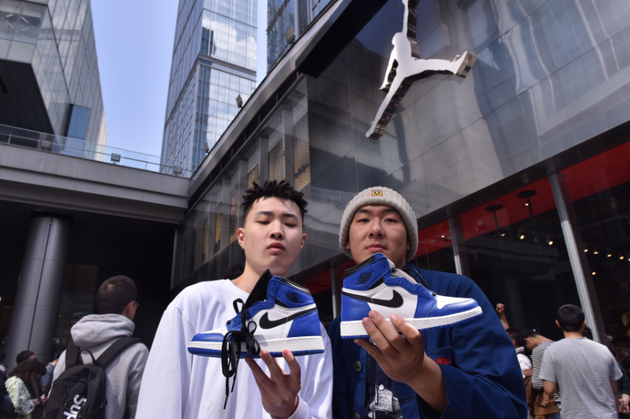Apr. 22 (NBD) -- "Normally, I spend 4,000-5,000 yuan (597-746 U.S. dollars) buying sneakers in a month. The most expensive pair I purchased are the Air Jordan 1 x OFF-WHITE collection which cost me 8,000 yuan last March. The products with an original price of 1,399 yuan are now for sale at 19,000 yuan," recalled, Yan Wu (alias), a 28-year-old shoes collector.
This February, the price of Li-Ning Way of Wade 7 "The Moment" basketball shoes skyrocketed to 12,319 yuan one day after the release of the new collection that was sold at 1,699 yuan on the official website.
Data from renowned shoe reseller platform StockX shows last year, the second-hand shoes from AJ, Nike (AJ not included) and Adidas posted a premium of 59 percent, 58 percent and 25 percent, respectively, from the initial selling prices.
Among all releases in 2018, the top three items, AJ ONE, Adidas Yeezy and AJ THREE, were priced at the premium of 99 percent, 30 percent and 31 percent, respectively, in the secondary market.

Chinese basketball and sneaker fans displaying the new releases Air Jordan 1 in Chengdu city in March 2018 (Photo/Dfic)
Scalpers of second-hand sneakers stock up in face of huge profitability
Now it is common that shoe prices on the secondary market is 30 percent higher than, or in some cases, several times the original price, a sneaker collector disclosed.
Considerable price differences motivate scalpers eyeing lucrative earnings to stockpile limited-edition sneakers.
In November last year, Lin Li (alias) flew to South China's Kunming where AJ's new joint collection will be launched, hiring 50 people for 200 yuan per day to purchase the shoes.
After queuing up for 24 hours, Lin reaped 21 of the total 26 pairs released in the city.
The buying spree was followed by high returns. Lin could earn about 4,000 yuan for each pair with a profit margin of over 210 percent.
In China's sneaker market, scalpers consist of small buyers who purchased shoes from the official stores and profited from price discrepancy and big buyers like Lin who stock up goods and purposely raised the selling prices, revealed the above mentioned sneaker collector.
The latter could snap up to 70-80 percent of limited-edition sneakers in popular sizes in the market.
Last year, an AJ joint collection previously sold at around 1,300 yuan was touted for up to 8,000-10,000 yuan overnight after scaplers' crazy stockpiling.
An anonymous scalper told news outlet Yicai that he earned monthly net profits of about 400,000 yuan last year.
Hunger marketing and third party's commission charge cause price surge
The market has been thriving since 2015 when the shoes started to be put on by the stars, along with the rise of sneaker fashion and joint collections.
It is predicted that the global sneaker market will exceed 95 billion U.S. dollars by 2025, business consulting firm Grand View Research reported.
Sports brand Nike and Adidas even began to sell limited editions by lottery and other ways. Less supplies and crossovers create trends and bring exposure for the giants, which further spurs the market boom.
The hunger marketing of sportswear firms and consumers' enthusiasm for limited collections finally results in the soaring second-hand prices of the products.
In addition, the commission fees charged by resale sites like Poizon are another push for price surge.
For example, the popular sneaker trading app Poizon charged every transaction 9.5 percent as commission and such costs are generally passed on to consumers.
However, to achieve better balance between brand value and consumer demand, some brands now is adjusting their marketing strategy.
Adidas and Nike and others began to increase supply. For AJ ONE, 170 pairs of replica sneakers in 40 styles were offered in 2018.
Email: gaohan@nbd.com.cn


 川公网安备 51019002001991号
川公网安备 51019002001991号





